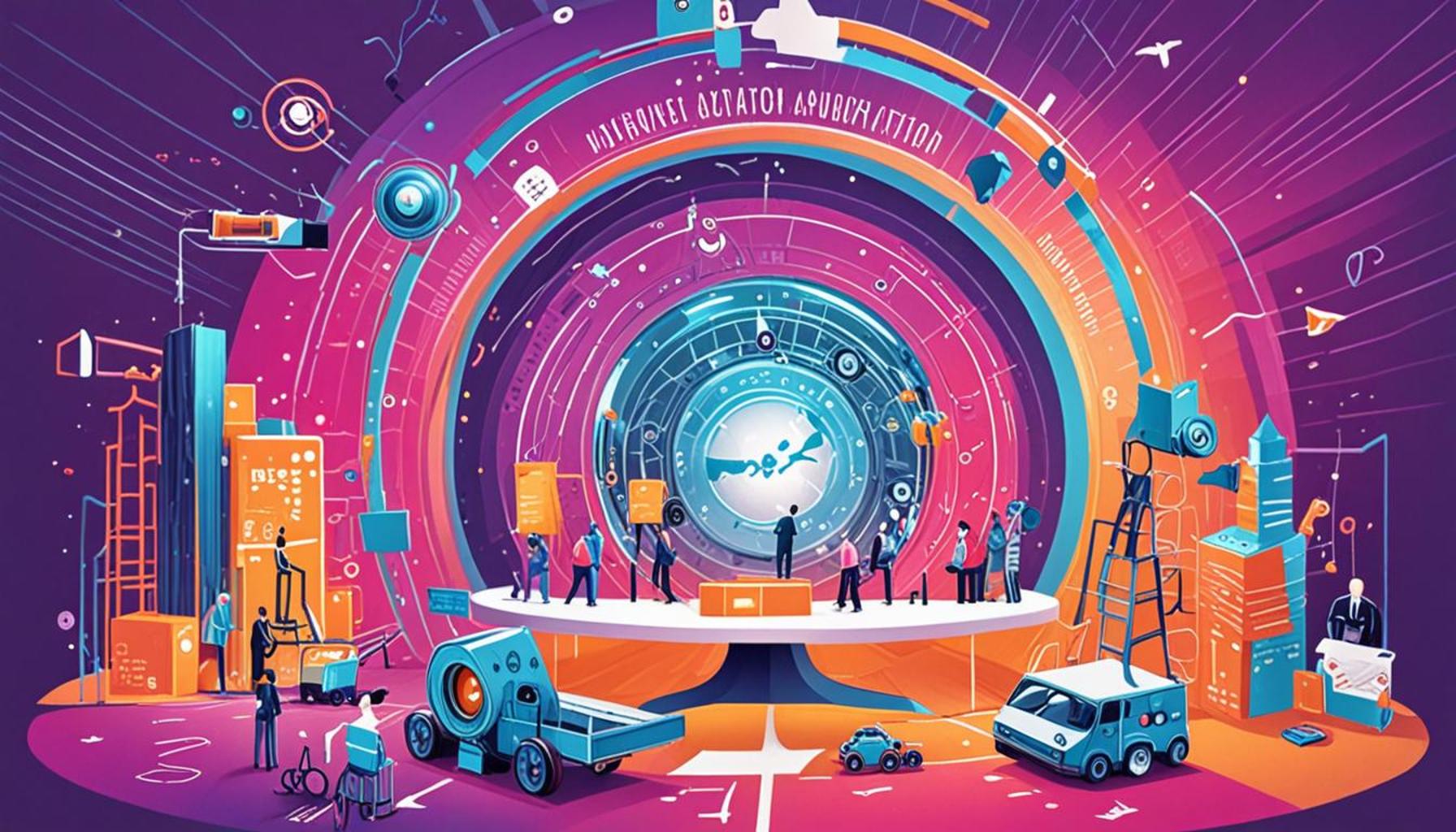How Marketing Automation Can Increase Transparency in Government Programs

The Importance of Transparency in Public Institutions
In today’s rapidly evolving landscape of digital communication, public institutions face increasing pressure to foster transparency as a means of building trust with citizens. The traditional view of government operations, often shadowed by bureaucratic complexity, is now being transformed through the adoption of marketing automation tools. These advanced systems not only streamline cumbersome processes but also promote accountability and openness, revolutionizing the dynamics between governments and the constituents they serve.
Benefits of Marketing Automation in Government
One of the most significant advantages of utilizing marketing automation within government programs is real-time tracking. With modern technology, citizens can access up-to-the-minute information about various initiatives, from the status of local infrastructure projects to updates on public health campaigns. For example, when Baltimore introduced an online dashboard during its COVID-19 response, residents were able to monitor vaccination rates and hospitalizations, thereby fostering a culture of accountability and reassurance.
Moreover, the role of data analytics cannot be overstated. By actively analyzing citizen feedback through online surveys and social media interactions, government agencies can make evidence-based decisions that reflect the needs and concerns of the population. This two-way communication not only enhances engagement but also allows for a more responsive governance model. Take the city of Los Angeles, for instance, where the Department of Transportation uses analytics to gauge public sentiment on transportation policies, ensuring that decisions made are in alignment with community interests.
Another critical element is personalized communication. Automation tools enable agencies to send tailored messages that resonate with specific demographics. For example, a local housing department might send different information to first-time homebuyers, renters, and seniors, ensuring that each group receives relevant updates about housing assistance programs. This targeted approach not only informs residents effectively but also empowers them to take advantage of available services.
Case Studies: Cities Leading the Way
Several cities across the United States are exemplary in implementing these strategies. San Francisco, for example, uses marketing automation to enhance its public messaging regarding waste management, providing residents with easy-to-understand information about recycling and composting schedules. Similarly, Chicago has leveraged marketing automation to streamline communication with constituents regarding city initiatives, thereby improving overall public trust.
Conclusion
A deeper exploration into the synergy between marketing automation and governmental transparency reveals profound implications for both stakeholders and citizens. As these innovative tools continue to develop, they serve as catalysts for change, paving the way for more transparent and accountable public service dynamics. As citizens we become accustomed to real-time information and more personal interactions with our government, the demand for such systems will likely grow, fueling further technological advancements and reforms.
SEE ALSO: Click here to read another article
Enhancing Public Engagement Through Marketing Automation
The advent of marketing automation technologies has created unique opportunities for governments to engage with their constituents in a more meaningful way. As citizens increasingly demand more information and involvement in governmental processes, automation offers essential tools for enhanced interaction. By strategically deploying these tools, governments can ensure that their communication is not only timely but also relevant to the public’s interests.
One of the pivotal benefits of marketing automation is the ability to utilize targeted email campaigns. This approach allows government agencies to segment their audience based on various criteria, such as geography, demographics, and interests. For instance, a city council in Texas might create tailored newsletters addressing specific community concerns like public safety, community events, and local development updates. By delivering content that resonates with residents’ concerns, agencies can foster a stronger sense of community ownership and involvement in public initiatives.
Alongside targeted communications, the use of social media integration within marketing automation platforms facilitates a more dynamic dialogue between governments and citizens. With more than 70% of Americans using social media platforms, leveraging these channels can amplify messages exponentially. Government accounts can share real-time updates about projects, solicit public opinions through forums, and even respond to inquiries promptly, thereby making operations more transparent. Popular platforms like Facebook and Twitter are proving invaluable as not only sources of information dissemination but also as channels for civic engagement, significantly minimizing the gap between citizens and officials.
Successful Implementation Strategies
To capitalize on the advantages of marketing automation, governmental agencies can implement several strategic steps:
- Define Clear Objectives: Establishing specific goals for what transparency means to the agency allows for targeted outcomes. Whether it’s improving response times or enhancing public participation, clear definitions guide program focus.
- Invest in Robust Software: Choosing appropriate marketing automation tools is essential. Agencies should look for platforms that provide user-friendly interfaces, comprehensive reporting features, and integrations with existing systems.
- Training and Development: Ensuring that staff is well-trained in using marketing automation tools is crucial. Providing ongoing professional development will equip teams to utilize resources effectively and innovatively.
- Monitor and Adapt: Collecting data on engagement metrics allows agencies to evaluate what strategies are effective. By monitoring progress, adjustments can be made to continually improve transparency and citizen engagement.
As seen through these strategies, marketing automation is not just a buzzword; it is a powerful ingredient in promoting transparency in government programs. By facilitating clear, timely, and personalized communication, governments can foster a culture of openness and trust—essential for a thriving democratic society.
| Category | Details |
|---|---|
| Real-Time Data Sharing | Marketing automation allows for immediate dissemination of information regarding government programs, keeping citizens informed. |
| Accountability Mechanisms | Through automated reporting tools, governments can ensure transparency in budgeting and decision-making processes. |
Incorporating marketing automation into government programs not only promotes transparency but also enhances public engagement. By utilizing automated systems, governmental bodies can provide consistent updates and easily accessible information to the public, fostering trust and collaboration between officials and constituents. For instance, open dashboards displaying real-time performance metrics can demystify how taxpayer money is spent, making citizens more aware of the impact of government initiatives.Moreover, as marketing automation tools continue to evolve, they offer advanced capabilities for analyzing citizen feedback and adapting programs accordingly. This creates a circular flow of communication whereby feedback informs improvements and enhances accountability, ensuring that programs meet the actual needs of the community. As these systems mature, their significance in shaping responsive governance will only grow.
ADDITIONAL INSIGHTS: Expand your understanding here
Data-Driven Decision Making to Foster Accountability
Incorporating marketing automation into government operations not only enhances communication but also promotes accountability through data-driven decision-making processes. In an era where citizens are increasingly vigilant about their governments’ actions, using robust data analytics tools, available through many marketing automation platforms, allows agencies to better understand public sentiment and improve program effectiveness.
For instance, by analyzing engagement metrics from email campaigns and social media interactions, government agencies can identify which topics garner the most interest among constituents. If data indicates a significant rise in inquiries about local environmental initiatives, for example, officials can prioritize communication around those initiatives. Such responsiveness demonstrates to the public that their concerns are being acknowledged and acted upon, thereby reinforcing trust in the systems governing them.
Transparency in Budgeting and Resource Allocation
Another critical area where marketing automation can contribute to transparency is in the realms of budgeting and resource allocation. Traditionally, budget documents can be dense and convoluted, making it challenging for the average citizen to understand how taxpayer money is being utilized. However, with the advent of web-based marketing automation tools, governments can craft visual dashboards that break down financial data into digestible formats.
For example, municipalities can create interactive online reports that allow citizens to see real-time budgetary information, project timelines, and the expected outcomes of funded initiatives. This kind of transparency not only allows for greater public oversight but also encourages civic engagement by inviting citizens to participate in discussions regarding budget priorities and project evaluations. Thus, marketing automation becomes a vehicle for collaboration rather than merely information dissemination.
Improving Accessibility for Diverse Audiences
Effective communication is more than just reaching an audience; it’s about ensuring that messages resonate with various demographics. Marketing automation tools allow government agencies to build content that is tailored to the diverse needs of their constituents. By employing advanced features such as multilingual support and accessibility options, governments can engage with non-English speaking populations, individuals with disabilities, and those from various socio-economic backgrounds.
For instance, the City of Los Angeles has utilized marketing automation to create multilingual outreach campaigns that ensure vital public health information reaches immigrant communities. By providing updates in multiple languages and adapting messages for cultural relevance, governments can foster inclusivity, ensuring that all citizens are informed and able to partake in civic activities. This level of engagement not only empowers individuals but also strengthens community bonds and promotes a culture of mutual respect and understanding.
Case Studies of Successful Implementation
Real-world applications of marketing automation showcasing transparency in government programs abound. The state of Virginia successfully launched a “Dashboard Virginia,” a transparent tool that employs marketing automation to report on public service performance metrics. This initiative not only enhances accessibility but also promotes citizen engagement by allowing stakeholders to track government efficiency in real time. By observing how concerns translate into concrete actions, citizens are more likely to remain engaged and invested in government programs.
Similarly, the city of Miami uses marketing automation to streamline public feedback on city development projects. By automating feedback collection through surveys and social media monitoring, they have taken significant steps to ensure that the public’s voice is not only heard but also acted upon. This dynamic approach symbolizes a significant evolution in government-citizen interaction, offering a glimpse into the potential of digitally enhanced transparency.
SEE ALSO: Click here to read another article
Conclusion: Transforming Government Transparency Through Marketing Automation
As the digital landscape continues to evolve, the role of marketing automation in enhancing transparency in government programs cannot be overstated. The tools and strategies that automation offers allow government entities to cultivate a more open and engaging dialogue with citizens, thereby fostering accountability and trust. By leveraging data analytics to understand public sentiment, agencies can refine their outreach efforts and ensure that communication is both responsive and relevant.
The move towards greater transparency in budgeting and resource allocation is facilitated by visual and interactive tools that make complex information accessible. For citizens who deserve clarity on how their tax dollars are spent, such initiatives not only improve understanding but also encourage active participation in civic discussions. Moreover, as marketing automation tools continue to evolve, they enhance the ability of governments to reach diverse audiences, ensuring that critical messages resonate with all demographic groups.
Examining successful case studies like “Dashboard Virginia” and Miami’s public feedback systems illustrates the tangible benefits of these technologies in promoting public oversight and engagement. This evolution towards automated solutions is not merely about information dissemination; it is about creating a collaborative environment where citizens feel empowered and informed. As we look to the future, embracing marketing automation within government operations can pave the way for a new standard of transparency that resonates with the public’s demand for open governance. The potential is vast, inviting further exploration into how these innovations can continue to bridge gaps and fortify the relationship between government and citizenry.


